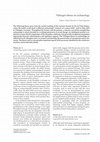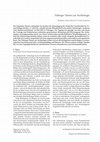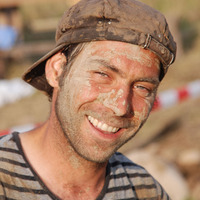Papers by Christoph Unglaub

Archäologie in Schleswig 19 , 2023
The western part of the North Frisian island
of Amrum is characterized by a wide
area of sand dun... more The western part of the North Frisian island
of Amrum is characterized by a wide
area of sand dunes. Beneath the dunes
the old geest landscape with prehistoric
settlement sites and burial grounds
is preserved. At the wind exposed site
Nebel LA 431 near the duck decoy Meeram
uncovered structures were documented
and small exploratory excavations
were carried out between 2020 and 2022.
Using modern methods, a farmstead of
the late pre-Roman Iron Age / early Roman
Imperial Period is being investigated
here. Several settlement sites had already
been documented by Hans Hingst in the
1960s and 1970s in the nearby surroundings.
The former occupation layer of the
settlement is characterized by extensive
stone pavements. These are partly covered
by a massive cultural layer containing
burnt clay, marine clay, charcoal, and
numerous pottery sherds. In addition
to a courtyard pavement preserved over
an area of about 25 m², in which a large
pit and a fireplace are embedded, it was
possible to document at least two socalled
manure gutters, carefully set out
of stones and representing the longitudinal
central passage in the livestock barn
section of the longhouse. Several oval
hearths, paved and partly covered with a
clay mantle, indicate the living part of the
house. Intensive traces of fire in the living
quarters suggest that this part of the
house had to be renewed at least once and
that several settlement phases presumably
overlap here. Furthermore, an old soil
with Neolithic flint artifacts beneath the
Iron Age settlement layer indicates older
settlement phases.

Veröffentlichungen zur Landesarchäologie Brandenburg, 2018
Seventy years after the end of the Second World War, hitherto unnoticed structures in Brandenburg... more Seventy years after the end of the Second World War, hitherto unnoticed structures in Brandenburg's forests from the time of the Battle of Berlin have begun to attract attention: groups of rectangular pits lined up with military precision alongside roads, dozens and sometimes hundreds of them often many rows deep. Only recently have these features been recognised as the remnants of Russian zeml-yankas, or wood-lined dugout shelters. The camps once served the organised demobilisa-tion of large troop units and the initial repatriation of hundreds of thousands of soldiers, as well as former POWs and forced labourers. In and around the houses, remnants of daily life in the Red Army can be found: among other items, pieces of equipment, badges, plates and cups, canteens and cutlery. Some items bear Cyrillic inscriptions. Soviet stars engraved on Wehrmacht belt buckles over erased swastikas , for example, reflect a desire of adornment with the symbol of victory. Civilian artefacts such as jewellery, watches, lighters, razors and even taps and bicycle parts confirm the narrative of the time. The finds raise questions, many of which are still unanswered-the archaeological and historical research has just begun.
Arbeitsberichte zur Bodendenkmalpflege in Brandenburg, 2018

by Diane Scherzler, Lisa Deutscher, Cyril Dworsky, Rengert Elburg, Raimund Karl, Katharina Möller, Guido Nockemann, Christiane Ochs, Kristin Oswald, Jochen Reinhard, Werner M Schön, Frank Siegmund, Christoph Unglaub, Jochim Weise, Jutta Zerres, and Chiara Zuanni (translation of / traduction de "Tübinger Thesen zur Archäologie")
The Tübingen theses on archae... more (translation of / traduction de "Tübinger Thesen zur Archäologie")
The Tübingen theses on archaeology grew from the annual meeting of the German Society for Pre & Proto-history: „Does the public create itself a different archaeology? Analyses of a power shift”, held in May, 2015 in Tübingen, Germany. Throughout the lectures and discussions, a common conviction emerged that archaeology is seized currently by a widespread process of social change. An intelligent reaction is required to ensure that the importance of the discipline continues to be generally recognized and granted appropriate financial, administrative and regulatory support. The Tübingen theses on archaeology are addressed to all colleagues active in research and teaching, the preservation of monuments and in museums. The theses seek to conceptualize important aspects of the processes identified by the conference members and to stimulate debate. //
Les thèses de Tübingen sur l‘archéologie sont apparues dans le cadre de la Conférence Annuelle du Deutsche Gesellschaft für Ur- und Frühgeschichte e. V. (DGUF - Société Allemande pour la Pré- et Protohistoire): “Le public crée-t-il une nouvelle archéologie? Analyse d‘un changement de pouvoir”, qui s‘est tenue en mai 2015 à Tübingen, en Allemagne. Au fil des discussions et des conférences, une conviction commune est apparue, selon laquelle un processus général de transformation sociale s’est emparé de l’archéologie aujourd’hui. Une réaction intelligente s’impose afin de garantir que l’importance de la discipline continue à être reconnue de façon générale et que lui soient attribués les moyens financiers, administratifs et légaux appropriés. Les thèses de Tübingen sur l‘archéologie sont destinées à tous les confrères, actifs dans la recherche et l’enseignement, dans la conservation des monuments et dans les musées. Dans ces thèses, on s’emploiera à conceptualiser des aspects importants des processus identifiés par les membres de la conférence et à stimuler le débat.

by Antonie Bassing-Kontopidis, Diane Scherzler, Lisa Deutscher, Cyril Dworsky, Rengert Elburg, Raimund Karl, Holger Kieburg, Carmen Löw, Katharina Möller, Guido Nockemann, Christiane Ochs, Kristin Oswald, Jochen Reinhard, Werner M Schön, Rainer Schreg, Frank Siegmund, László Matthias Simon-Nanko, Christoph Unglaub, Jochim Weise, Jutta Zerres, and Chiara Zuanni Die Tübinger Thesen zur Archäologie entstanden im Kontext der Jahrestagung der Deutschen Gesellsc... more Die Tübinger Thesen zur Archäologie entstanden im Kontext der Jahrestagung der Deutschen Gesellschaft für Ur- und Frühgeschichte e. V. (DGUF): "Schafft sich die Öffentlichkeit eine andere Archäologie? Analysen einer Machtverschiebung" im Mai 2015 in Tübingen. Die Tagung war geprägt von einer sich durch die Vorträge und Diskussionen ziehenden gemeinsamen Stimmung und Überzeugung: Die Archäologien sind gegenwärtig erfasst von einem umfassenden gesellschaftlichen Wandlungsprozess, in dem die Akteure klug handeln sollten, wenn sie weiterhin oder wieder integraler Bestandteil der Gesellschaft sein wollen, ausgestattet mit einer angemessenen finanziellen, personellen und regulativen Basis. Die Tübinger Thesen zur Archäologie richten sich an alle Kolleginnen und Kollegen in archäologischer Forschung und Lehre, in Denkmalpflege und Museen. Die Thesen wollen wichtige Aspekte der von den Tagungsteilnehmern identifizierten Prozesse thematisieren und Denkanstöße geben.
Archäologie in Berlin und Brandenburg 2012











Uploads
Papers by Christoph Unglaub
of Amrum is characterized by a wide
area of sand dunes. Beneath the dunes
the old geest landscape with prehistoric
settlement sites and burial grounds
is preserved. At the wind exposed site
Nebel LA 431 near the duck decoy Meeram
uncovered structures were documented
and small exploratory excavations
were carried out between 2020 and 2022.
Using modern methods, a farmstead of
the late pre-Roman Iron Age / early Roman
Imperial Period is being investigated
here. Several settlement sites had already
been documented by Hans Hingst in the
1960s and 1970s in the nearby surroundings.
The former occupation layer of the
settlement is characterized by extensive
stone pavements. These are partly covered
by a massive cultural layer containing
burnt clay, marine clay, charcoal, and
numerous pottery sherds. In addition
to a courtyard pavement preserved over
an area of about 25 m², in which a large
pit and a fireplace are embedded, it was
possible to document at least two socalled
manure gutters, carefully set out
of stones and representing the longitudinal
central passage in the livestock barn
section of the longhouse. Several oval
hearths, paved and partly covered with a
clay mantle, indicate the living part of the
house. Intensive traces of fire in the living
quarters suggest that this part of the
house had to be renewed at least once and
that several settlement phases presumably
overlap here. Furthermore, an old soil
with Neolithic flint artifacts beneath the
Iron Age settlement layer indicates older
settlement phases.
The Tübingen theses on archaeology grew from the annual meeting of the German Society for Pre & Proto-history: „Does the public create itself a different archaeology? Analyses of a power shift”, held in May, 2015 in Tübingen, Germany. Throughout the lectures and discussions, a common conviction emerged that archaeology is seized currently by a widespread process of social change. An intelligent reaction is required to ensure that the importance of the discipline continues to be generally recognized and granted appropriate financial, administrative and regulatory support. The Tübingen theses on archaeology are addressed to all colleagues active in research and teaching, the preservation of monuments and in museums. The theses seek to conceptualize important aspects of the processes identified by the conference members and to stimulate debate. //
Les thèses de Tübingen sur l‘archéologie sont apparues dans le cadre de la Conférence Annuelle du Deutsche Gesellschaft für Ur- und Frühgeschichte e. V. (DGUF - Société Allemande pour la Pré- et Protohistoire): “Le public crée-t-il une nouvelle archéologie? Analyse d‘un changement de pouvoir”, qui s‘est tenue en mai 2015 à Tübingen, en Allemagne. Au fil des discussions et des conférences, une conviction commune est apparue, selon laquelle un processus général de transformation sociale s’est emparé de l’archéologie aujourd’hui. Une réaction intelligente s’impose afin de garantir que l’importance de la discipline continue à être reconnue de façon générale et que lui soient attribués les moyens financiers, administratifs et légaux appropriés. Les thèses de Tübingen sur l‘archéologie sont destinées à tous les confrères, actifs dans la recherche et l’enseignement, dans la conservation des monuments et dans les musées. Dans ces thèses, on s’emploiera à conceptualiser des aspects importants des processus identifiés par les membres de la conférence et à stimuler le débat.
of Amrum is characterized by a wide
area of sand dunes. Beneath the dunes
the old geest landscape with prehistoric
settlement sites and burial grounds
is preserved. At the wind exposed site
Nebel LA 431 near the duck decoy Meeram
uncovered structures were documented
and small exploratory excavations
were carried out between 2020 and 2022.
Using modern methods, a farmstead of
the late pre-Roman Iron Age / early Roman
Imperial Period is being investigated
here. Several settlement sites had already
been documented by Hans Hingst in the
1960s and 1970s in the nearby surroundings.
The former occupation layer of the
settlement is characterized by extensive
stone pavements. These are partly covered
by a massive cultural layer containing
burnt clay, marine clay, charcoal, and
numerous pottery sherds. In addition
to a courtyard pavement preserved over
an area of about 25 m², in which a large
pit and a fireplace are embedded, it was
possible to document at least two socalled
manure gutters, carefully set out
of stones and representing the longitudinal
central passage in the livestock barn
section of the longhouse. Several oval
hearths, paved and partly covered with a
clay mantle, indicate the living part of the
house. Intensive traces of fire in the living
quarters suggest that this part of the
house had to be renewed at least once and
that several settlement phases presumably
overlap here. Furthermore, an old soil
with Neolithic flint artifacts beneath the
Iron Age settlement layer indicates older
settlement phases.
The Tübingen theses on archaeology grew from the annual meeting of the German Society for Pre & Proto-history: „Does the public create itself a different archaeology? Analyses of a power shift”, held in May, 2015 in Tübingen, Germany. Throughout the lectures and discussions, a common conviction emerged that archaeology is seized currently by a widespread process of social change. An intelligent reaction is required to ensure that the importance of the discipline continues to be generally recognized and granted appropriate financial, administrative and regulatory support. The Tübingen theses on archaeology are addressed to all colleagues active in research and teaching, the preservation of monuments and in museums. The theses seek to conceptualize important aspects of the processes identified by the conference members and to stimulate debate. //
Les thèses de Tübingen sur l‘archéologie sont apparues dans le cadre de la Conférence Annuelle du Deutsche Gesellschaft für Ur- und Frühgeschichte e. V. (DGUF - Société Allemande pour la Pré- et Protohistoire): “Le public crée-t-il une nouvelle archéologie? Analyse d‘un changement de pouvoir”, qui s‘est tenue en mai 2015 à Tübingen, en Allemagne. Au fil des discussions et des conférences, une conviction commune est apparue, selon laquelle un processus général de transformation sociale s’est emparé de l’archéologie aujourd’hui. Une réaction intelligente s’impose afin de garantir que l’importance de la discipline continue à être reconnue de façon générale et que lui soient attribués les moyens financiers, administratifs et légaux appropriés. Les thèses de Tübingen sur l‘archéologie sont destinées à tous les confrères, actifs dans la recherche et l’enseignement, dans la conservation des monuments et dans les musées. Dans ces thèses, on s’emploiera à conceptualiser des aspects importants des processus identifiés par les membres de la conférence et à stimuler le débat.